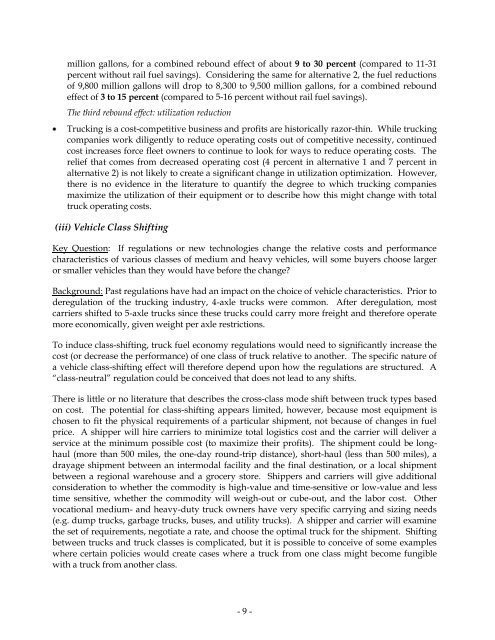Assessment of Fuel Economy Technologies for Medium and Heavy ...
Assessment of Fuel Economy Technologies for Medium and Heavy ...
Assessment of Fuel Economy Technologies for Medium and Heavy ...
Create successful ePaper yourself
Turn your PDF publications into a flip-book with our unique Google optimized e-Paper software.
million gallons, <strong>for</strong> a combined rebound effect <strong>of</strong> about 9 to 30 percent (compared to 11-31<br />
percent without rail fuel savings). Considering the same <strong>for</strong> alternative 2, the fuel reductions<br />
<strong>of</strong> 9,800 million gallons will drop to 8,300 to 9,500 million gallons, <strong>for</strong> a combined rebound<br />
effect <strong>of</strong> 3 to 15 percent (compared to 5-16 percent without rail fuel savings).<br />
The third rebound effect: utilization reduction<br />
Trucking is a cost-competitive business <strong>and</strong> pr<strong>of</strong>its are historically razor-thin. While trucking<br />
companies work diligently to reduce operating costs out <strong>of</strong> competitive necessity, continued<br />
cost increases <strong>for</strong>ce fleet owners to continue to look <strong>for</strong> ways to reduce operating costs. The<br />
relief that comes from decreased operating cost (4 percent in alternative 1 <strong>and</strong> 7 percent in<br />
alternative 2) is not likely to create a significant change in utilization optimization. However,<br />
there is no evidence in the literature to quantify the degree to which trucking companies<br />
maximize the utilization <strong>of</strong> their equipment or to describe how this might change with total<br />
truck operating costs.<br />
(iii) Vehicle Class Shifting<br />
Key Question: If regulations or new technologies change the relative costs <strong>and</strong> per<strong>for</strong>mance<br />
characteristics <strong>of</strong> various classes <strong>of</strong> medium <strong>and</strong> heavy vehicles, will some buyers choose larger<br />
or smaller vehicles than they would have be<strong>for</strong>e the change<br />
Background: Past regulations have had an impact on the choice <strong>of</strong> vehicle characteristics. Prior to<br />
deregulation <strong>of</strong> the trucking industry, 4-axle trucks were common. After deregulation, most<br />
carriers shifted to 5-axle trucks since these trucks could carry more freight <strong>and</strong> there<strong>for</strong>e operate<br />
more economically, given weight per axle restrictions.<br />
To induce class-shifting, truck fuel economy regulations would need to significantly increase the<br />
cost (or decrease the per<strong>for</strong>mance) <strong>of</strong> one class <strong>of</strong> truck relative to another. The specific nature <strong>of</strong><br />
a vehicle class-shifting effect will there<strong>for</strong>e depend upon how the regulations are structured. A<br />
―class-neutral‖ regulation could be conceived that does not lead to any shifts.<br />
There is little or no literature that describes the cross-class mode shift between truck types based<br />
on cost. The potential <strong>for</strong> class-shifting appears limited, however, because most equipment is<br />
chosen to fit the physical requirements <strong>of</strong> a particular shipment, not because <strong>of</strong> changes in fuel<br />
price. A shipper will hire carriers to minimize total logistics cost <strong>and</strong> the carrier will deliver a<br />
service at the minimum possible cost (to maximize their pr<strong>of</strong>its). The shipment could be longhaul<br />
(more than 500 miles, the one-day round-trip distance), short-haul (less than 500 miles), a<br />
drayage shipment between an intermodal facility <strong>and</strong> the final destination, or a local shipment<br />
between a regional warehouse <strong>and</strong> a grocery store. Shippers <strong>and</strong> carriers will give additional<br />
consideration to whether the commodity is high-value <strong>and</strong> time-sensitive or low-value <strong>and</strong> less<br />
time sensitive, whether the commodity will weigh-out or cube-out, <strong>and</strong> the labor cost. Other<br />
vocational medium- <strong>and</strong> heavy-duty truck owners have very specific carrying <strong>and</strong> sizing needs<br />
(e.g. dump trucks, garbage trucks, buses, <strong>and</strong> utility trucks). A shipper <strong>and</strong> carrier will examine<br />
the set <strong>of</strong> requirements, negotiate a rate, <strong>and</strong> choose the optimal truck <strong>for</strong> the shipment. Shifting<br />
between trucks <strong>and</strong> truck classes is complicated, but it is possible to conceive <strong>of</strong> some examples<br />
where certain policies would create cases where a truck from one class might become fungible<br />
with a truck from another class.<br />
- 9 -
















